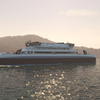Work on reviewing regulations to reduce emissions of air pollutants from ships was high on the agenda when the IMO Sub-Committee on Bulk Liquids and Gases (BLG) met for its 11th session from 16-20 April 2007. It followed on from an intersessional meeting of the BLG Working Group on Air Pollution, which took place from 13 to 17 November 2006, in Oslo, Norway, to develop the necessary MARPOL amendments. The Working Group on Air Pollution was reconvened during the current session, chaired by Mr. Bryan Wood-Thomas (United States), to progress the work in hand.
NOx emission limits for new engines
The Working Group reviewed the proposed three-tier system approach for NOx emission limits applicable to new engines, under which Tier I would be the current limits in MARPOL Annex VI, Tier II would represent the best available in-engine technology, with potential reductions of NOx emissions of 15 to 25 per cent depending on engine type, and Tier III would impose more stringent limits requiring further development or the use of different after-treatment techniques.
The Working Group agreed to a 1 January 2011 implementation date for Tier II, with a possible reduction of 2 to 3.5 grams of NOx per kilowatt/hour across the current NOx curve attainable through in-engine design.
The Working Group generally agreed that 2015/2016 was an appropriate timeframe for implementation of the Tier III NOx regulations for new engines. A table was developed outlining three proposals currently under consideration:
· Option X, giving an 80 per cent reduction from Tier I levels, using Selective Catalytic Reduction (SCR) Aftertreatment or Humid Air Motor (HAM) technology (which has produced excellent emission results, but is limited in application to date), to be applicable to all marine diesel engines within 50 nautical miles from shore (worldwide);
· Option Y, giving an 83-85% per cent reduction from Tier I levels when in use, using Aftertreatment (SCR) or HAM, to be applicable to engines on large vessels only, in specific near-shore areas;
· Option Z, giving a 40-50% per cent reduction from Tier I levels, using Advanced In-Engine Modifications or Exhaust Gas Recirculation (EGR), to be applied to all marine diesel engines on a global basis.
Existing Engines
In discussing how to reduce emissions from existing engines (pre-2000), the Working Group reached a preliminary conclusion that emission modifications are technically feasible for many pre-2000 large-displacement engines – but some pre-2000 engines would not be appropriate for modification. It was noted that, for some engines, there would be significant practical difficulties due to the unavailability of parts, since some engine manufacturers are no longer in business.
The Sub-Committee noted the discussions, including agreement in the Working Group that changes would need to be made to the NOx Technical Code to simplify the relevant certification procedures for pre-2000 engines.
Sulphur and Fuel Oil Quality Discussion
The Sub-Committee noted the Working Group’s consideration of options for addressing sulphur emissions. Regulation 14 of MARPOL Annex VI, on Sulphur Oxides (SOx), currently includes a global cap of 4.5% m/m on the sulphur content of fuel oil and contains provisions allowing for special SOx Emission Control Areas (SECAS) to be established in which the sulphur content of fuel oil used onboard ships must not exceed 1.5% m/m. Alternatively, ships must fit an exhaust gas cleaning system.
The Working Group prepared a table outlining the various options, and noted that, with further consideration, it should be possible to reduce the options further, while the final solution may involve a hybrid or variant of the options currently under consideration. Taking into account the discussions in the working group, the current options are as follows:
Reference baseline (previously referred to as Option A: Status quo)
The current requirements of regulation 14.
Option B: Change to SECA requirements
Keep the current structure of regulation 14, with a global sulphur cap (unchanged or lowered) and a SECA sulphur cap lowered first to 1.00% by a tentative date of 2010, then to 0.50%, possibly by 2015.
Option B1:
Within a defined distance from shore, set a lower limit for SOx emissions or require the use of a distillate fuel with low sulphur level. Allow for shipowners to choose to comply through the use of low-sulphur distillate fuel and/or the use of exhaust gas cleaning technology. Also include a limit on emissions of particulate matters.
Option B2:
Gradual lowering of the global sulphur cap content (max 3.0% in 2012, max 1.5% in 2016), or use of alternative mechanisms (such as exhaust gas cleaning systems) to obtain equivalent levels of emission reduction. Additionally, require use of distillate in SECAs, port areas and estuaries, with gradual lowering of the sulphur content (max 1.0% in 2011, max 0.5% in 2015), or use of alternative mechanisms (such as exhaust gas cleaning systems) to obtain equivalent levels of emission reduction.
Option C: Change to distillate fuels
This would require use of distillate fuels for all ships, with a global sulphur cap set at 1.00% by a possible date of 2012, then reduced further to 0.50%, possibly by 2015. The specification for the distillate fuel to be used by ships would need to be included in the regulation.
Option C2: Distillate fuel with option of residual fuel
Global caps as in Option C, but allow for the use of residual fuel in combination with alternative mechanisms (such as an exhaust gas cleaning system) to obtain an equivalent level of emission reduction.
Emission trading
The Sub-Committee noted discussions in the Working Group relating to proposed amendments to the current regulation 4 of Annex VI to allow coastal States and Administrations to conduct trials of economic instruments such as differentiated fairway dues, emission trading or any other similar scheme, on the basis that such schemes would be voluntary and within the Exclusive Economic Zone of the State or States involved.
Within the Working Group, many delegations supported the introduction of limited trials but held reservations concerning the establishment of permanent economic mechanisms under the Annex. It was agreed the proposed revised regulation should be forwarded for further consideration.
Volatile Organic Compounds (VOC)
The Sub-Committee agreed in principle to proposed amendments to MARPOL Annex VI, regulation 15, to prevent emissions of volatile organic compounds (VOCs) from tankers, as proposed by the Working Group.
While Annex VI currently allows for emissions of VOCs from tankers to be regulated in ports or terminals under the jurisdiction of a Party to the Protocol of 1997, the proposed new regulation would require every tanker carrying crude oil to have on board, and implement, a VOC management plan.
The VOC management plan would need to be approved by the Administration (flag State) and would have to include written procedures for minimizing VOC emissions during loading, sea passage and discharge of cargo, give considerations to the extra VOC generated by crude oil washing and designate a person responsible for implementing the plan. The plan would be written in the working language of the ship crew. If the language used is not English, French or Spanish, a translation into one of these languages would be included.
The Sub-Committee also agreed proposed draft guidelines for the development of a VOC management plan.
Proposed work plan
The Sub-Committee agreed to recommend to the MEPC in July that an intersessional BLG Working Group meet before the end of 2007 to progress its work. The intersessional Working Group would report to the next BLG session in February 2008, which would, in turn, make its recommendations to MEPC 57 (March/April 2008), with a view to approving amendments to the regulations at that session, followed by their adoption at MEPC 58 in October 2008.
Subscribe for
Maritime Reporter E-News
Maritime Reporter E-News is the maritime industry's largest circulation and most authoritative ENews Service, delivered to your Email five times per week










